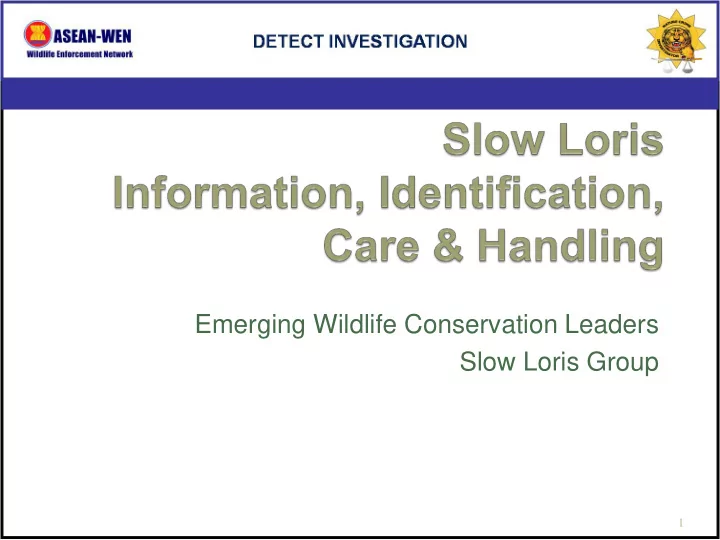

Emerging Wildlife Conservation Leaders Slow Loris Group 1
Welcome Brandon Speeg What is Emerging Wildlife Conservation Leaders? Zoologist White Oak Conservation Center Ungulates (hoofed animals) 2
• Information • Identification • Care & Handling 3
4
Key Facts Primate Domestic and international legislation protects the slow loris Native to countries in Southeast Asia Nocturnal - active at night 5
CITES Listing Convention on International Trade in Endangered Species (CITES) of Wild Fauna and Flora Appendix I listed All international commercial trade banned 6
IUCN Listing International Union for the Conservation of Nature Endangered N. javanicus Vulnerable N. pygameus N. bengalensis N. coucang N. menagensis 7
Some Range Country Listings Country Regulation Singapore Endangered Species (Import and Export Act Cap 82A (ESA) Wild Animals and Birds Act Indonesia Decree No. 66 1973 of Ministry of Agriculture Gov. Reg. No. 7 1999 concerning protection of Wild Fauna and Flora Act No. 5 1999 Thailand Wildlife Protection Act 1992 Vietnam Decree 32 2006 ND-CP Cambodia PRAKAS 020 Malaysia Schedule 1 of totally protected animals India Schedule 1 of Wildlife (Protection) Act 1972 8
Use in Traditional Medicine All body parts used in traditional medicine In Cambodia, slow loris was the second most common mammal observed at markets 9
Use in Pet Trade • The pet trade is local, regional and international • Popular as a pet in range countries, and in China, Japan, Middle East, Russia, and Europe • Prices seen from US$6 in Indonesia to US$1,500- $4,500 in Japan • Easy to capture 10
11
Slow Loris Species Five species of slow loris are currently recognized Variation between species in size, markings and coloring Nycticebus coucang Greater N. bengalensis Bengal N. menagensis Bornean N. javanicus Javan N. pygmaeus Pygmy/Lesser 12
Slow Loris Species Range N. coucang Greater Indonesia (Sumatra), Malaysia, Thailand, Singapore N. bengalensis Bengal Thailand, Vietnam, Cambodia, China, India, Laos, Myanmar N. menagensis Bornean Malaysia, Indonesia (Kalimantan), Brunei, Philippines N. javanicus Javan Indonesia (Java) N. pygmaeus Pygmy Vietnam, Lao, Cambodia, China, East Thailand? 13
Facial and Body Markings Identifying species in the market can help you determine if it is domestic or international trade Facial markings present in all slow lorises but variation in pattern Between and within species Slow lorises vary in color 14
Points to Note on Identification Variation within species Chirping noise = juvenile May not exhibit all species characteristics Look similar across the species Use fur characteristics to identify young animals. Use facial and body markings to identify adult animal 15
Identification Difficulties Often dyed a different colour to make them more appealing Sick or malnourished animals often underweight or do not exhibit all species characteristics If in doubt as to what species, call an expert 16
17
Diet The slow loris has a diverse diet in the wild: Insects Floral nectar Sap Gum Fruit 18
Uses Toxin as Defense Lifts arms to lick secretion from inner elbow gland Mixture of saliva and toxic secretion is injected into predator with a bite Can send predators, including humans, into anaphylactic shock 19
Poor Conditions at Animal Markets Bites are common when kept in small cages Stress has a detrimental effect on its health Diets inadequate and animals often dehydrated Infants rarely survive Roger Allen, IAR 20
Teeth extraction Teeth often extracted by traders with nail clippers without anaesthetics to make it seem younger and avoid bites Can often cause lethal infection Difficult to return them to the wild 21
Immediate post-confiscation care Handle gently with gloves Place in a box or container that allows air supply If the animal is in a secure cage that can be confiscated and moved, leave the animal in the cage rather than cause stress by capturing and moving the animal into a new cage. Consider draping the container on three sides with a blanket to reduce stress, as long as ventilation is not stopped 22
Immediate post-confiscation care Do not use a chicken wire cage. If a chicken wire cage must be used, put a towel or foliage down to protect their feet and hands. Slow loris can escape through narrow gaps, so the container should be secured. The container should be kept at a temperature of 19 ° - 30 ° C; injured and weakened animals are more susceptible to heat and cold stress. Slow lorises should be transported in non air-conditioned vehicles. 23
Immediate post-confiscation care Adding leaves and branches (bamboo) to a container can reduce stress by giving the animal a place to hide and something to grasp. If holding the animal for an extended time in a large container, consider adding a smaller box or tube for the animal to hide and sleep in. Do not put two animals in a same small container if they were not together when confiscated. Place the animal somewhere quiet. Take to rescue centre as soon as possible. 24
Immediate post-confiscation care • Place water and food such as fruit (watermelon or banana) or crickets in the box. • Evaporated milk for infants. • Possible food items: Insects: Fruits: Vegetables: crickets banana squash mealworms grapes Peas beetles (small) apple Beans caterpillars mango corn peeled orange beans Other: kiwi spinach boiled egg whites durian yam papaya 25
This training was made possible by funding from the International Fund for Animal Welfare and the World Wildlife Fund This presentation was originally created by Tricia Parish and Dr. KAI Nekaris of Oxford Brookes University. Parish, T.J. 2008. Identifying CITES Appendix I-listed slow lorises (Primates: Lorisidae: Nycticebus): a training programme for enforcement officials and rescue centres in Southeast Asia. MSc Thesis. Oxford Brookes University, Oxford: UK . Thanks to the following people for the use of their photos: Edwin Wiek, Manoon Pliwsungnoen, Norman Lim, David Haring, San Diego Zoo, Anna Nekaris, Karmele Llano Sanchez, Alan Knight, Ulrike Streicher, Tilo Nadler, Carly Starr, Tim Redford, Dwi Nugroho, R. Butler, International Animal Rescue, Helga Schulze. 26
Recommend
More recommend